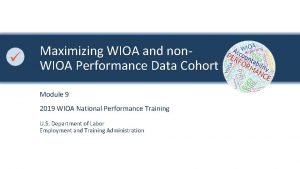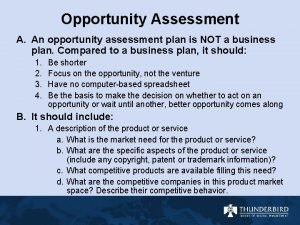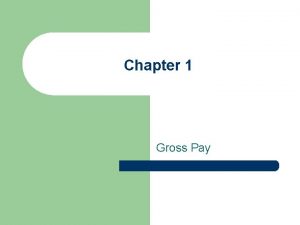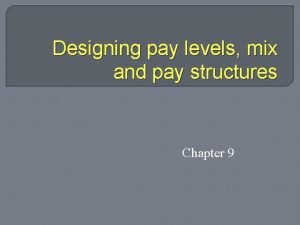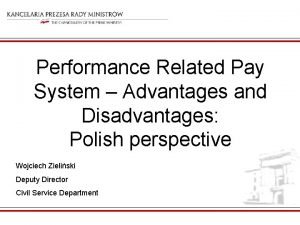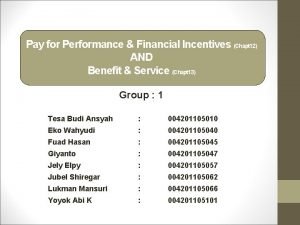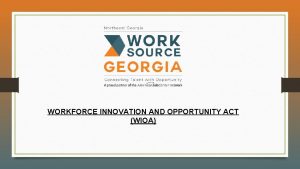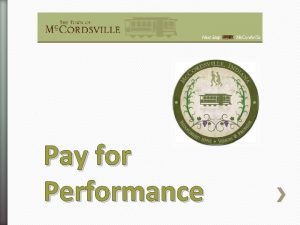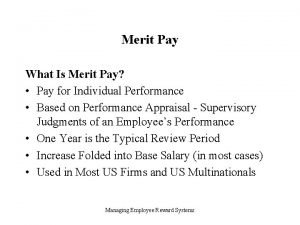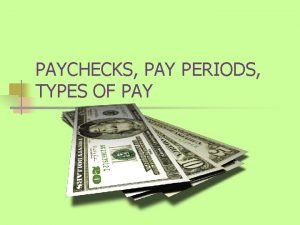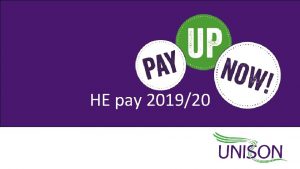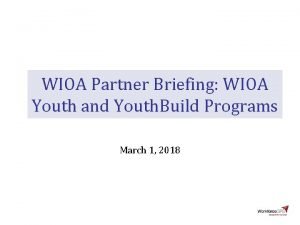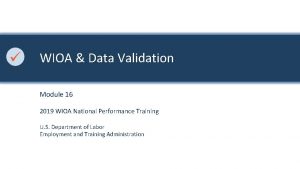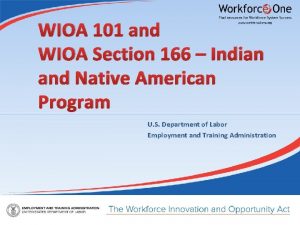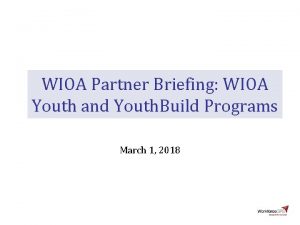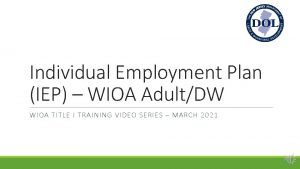Pay for Performance in WIOA An Opportunity for






































- Slides: 38

Pay for Performance in WIOA: An Opportunity for Innovation and Better Outcomes January 27, 2016

Introductions • Moderator: Katherine Klem, White House • Panelists: § John Colbert, Capital Hill Partners § Samra Haider, Center for Employment Opportunities § Jerry Croan, Third Sector Capital Partners

Overview 1. What is Pay for Performance? 2. Details of Pay for Performance 3. A service provider’s perspective 4. Resources to help you to use Pay for Performance 5. Q&A

What Is Pay for Performance? • An approach that uses government dollars for outcomes, not inputs or outputs • Allows states and localities to use WIOA formula funds for outcomes important to them – not on inputs

Why Is Pay for Performance Important?

Details of Pay for Performance in WIOA John Colbert Capital Hill Partners

WIOA Pay for Performance (PFP) �First permanent federal statutory authority embedding outcome based strategies

Who can spend what? �States can use any portion of their WIOA funds across all three funding streams for PFP �Can also augment with non-federal funds

Who can spend what? �Local areas can use up to 10% for PFP �States can provide T. A. to WIBs on PFP

These are not necessarily Social Impact Bonds �No third party investor is required (though this approach is allowable) �It is a direct contract between a state or WIB and a service provider

Outcomes are negotiated �PFP is an opportunity for states and localities to develop projects directly with CBOs and other contractors focused on mutually negotiated outcomes

Payments only upon outcomes �Payments are made if, and only if, specific outcomes are achieved

Little risks to the states �The financial risk to states and localities is de minimis, only paying for a provider’s successful outcomes

Helpful approach in targeting the hard to serve �States and localities can use PFP to create incentives for providers to successfully assist harder to serve participants such as: - Long term unemployed - Ex-offenders - Returning Vets - At risk youth

Can be an “anti-creaming” approach �PFP contracts can reverse “creaming. ” Successful placements of harder to serve participants mean larger rewards for contractors.

Bonus payments allowable �PFP can also be used to reward providers for meeting high bar outcomes

Pf. P can be combined with performance-based contracts �WIOA – no limits for locals in the use of performance-based contracting �Only 10% of local WIOA funds can be used for PFP �Outcome-based approaches can be augmented by combining PFP with traditional performance contracts

Pf. P can be combined with performance-based contracts How? �Traditional performance-based contracting provides pay points to contractors for reaching incremental milestones �PFP funds can be used to provide bonus payments for reaching specific high bar outcomes

Pf. P offers great flexibility �States and locals have tremendous flexibility in the development of pay for performance contracts �States and local WIBs can negotiate specific outcomes with contractors based on their state or regional workforce needs

Pf. P funding is “no year” money �The WIOA NPRM allows funds dedicated to PFP to be available until expended �WIOA formula fund time limits are eliminated Allows contracts to be developed based on realistic timelines, so long as activity can be documented toward the contracted goals.

PFP can be redeployed �If a PFP service provider does not meet its negotiated goals – no payment by state or local - Funds can be redeployed to successful Pf. P providers - Funds can be utilized for same or different outcomes - Choice is up to the state or local

Service Providers do not need to be on ETP list �WIOA draft rulemaking allows new service providers eligible for funding �PFP contracts can now be awarded to intermediaries, community based organizations, as well as community colleges �Services providers do not have to be on a state’s Eligible Training Provider list

What can I do now? Be bold – Act Now Include PFP as a workforce strategy in your WIOA state plan

A Service Provider’s Perspective Samra Haider Center for Employment Opportunities

CEO Program Model 1 3 TRANSITIONAL EMPLOYMENT All Life Skills Education graduates are placed into transitional employment on CEO work crews RECRUITMENT 2 LIFE SKILLS EDUCATION Participants attend a 4 day life skills education course 4 JOB COACHING Prepares participants to become “Job Start Ready” and eligible for placement services 5 JOB DEVELOPMENT/ PLACEMENT Matches participant w/ potential employment opportunities JOB PLACEMENT Participants are placed into unsubsidized employment 6 RETENTION SERVICES 12 months of ongoing support after placement including monetary incentives (Rapid Rewards)

CEO is a Proven Solution to the Problem of Recidivism In 2012, MDRC released the results of a three-year random assignment evaluation which showed that the CEO model reduces recidivism CEO’s Impact on: Public Safety Public Spending • Statistically significant reductions on all measures of recidivism • Over 20% reduction in reconviction and returns to incarceration • Over 3: 1 Benefit: Cost Ratio • Up to $3. 30 saved for every tax payer dollar spent or $8, 336 saved person CEO had the best results with higher risk and recently released clients – those at the highest risk of recidivism 1. http: //www. acf. hhs. gov/news/press/2012/NYEmploy. Ex. Prisoner. html These results were driven by those recently released from incarceration.

PFS Lead Responsibilities – A Close Partnership Project Design CEO Social Finance, Inc Program design and implementation including Performance management plan Implementation Recruitment and retention Provide high-quality services to participants NYS Convene and mobilize stakeholders Cost-benefit analysis Legal/contract framework; Negotiation of SIB contract Capital raise Investor relations and ongoing reporting Political alignment (legislature) Agency alignment Legislation for appropriation Negotiate payments and PFS contract Evaluation and related reporting USDOL grant reporting Appropriate funds Shared Active performance management Develop PFS Contract, economic modeling Select Outcomes, evaluation design, data collection and analysis, reporting, SIB governance

Resources to Help You Use Pay for Performance Jerry Croan Third Sector Capital Partners

Third Sector is America’s leading practitioner of Pay for Success Mission Who We Are Accelerate America’s transition to a performance driven social sector Third Sector Capital Partners, Inc. is a 501(c)3 nonprofit advisory firm that collaborates with government, funders, and service providers to address social needs through Pay for Success initiatives Our Work • • Launched $28 million Massachusetts juvenile justice project Launched $5 million Cuyahoga family homelessness project 37 projects in development nationwide The only national full service advisor awarded a federal Social Innovation Fund grant: $1. 9 million to support feasibility studies with state and local governments Our Team • • 32 team members Expertise across government, private, and nonprofit sectors © 2015, Third Sector Capital Partners, Inc.

WIOA Pay for Performance (PFP) & Pay for Success (PFS) • WIOA Pay for Performance (PFP) is very similar in concept to Pay for Success (PFS), but with its own unique twists – May or may not involve funds from private sector investors – Must use WIOA performance measures (but could add others) – Does not require an intermediary (but could have one) – Built-in authority to make success payments, but still must follow appropriate regulations © 2015, Third Sector Capital Partners, Inc.

WIOA & Pay for Performance (PFP): State/Local Roles • In general, WIOA’s PFP provisions are broad and delegate most authority to local boards. • The states must publish performance outcome reports and evaluate PFP. • States may provide technical assistance, and may provide contract incentives. • PFP opens up additional opportunities for blending and braiding of funds with other State/local programs with different combinations of outcomes-based and traditional services-based contracts © 2015, Third Sector Capital Partners, Inc.

Third Sector is a proud grantee of the Social Innovation Fund Pay for Success Program Furthermore, Third Sector is thrilled to partner with: © 2015, Third Sector Capital Partners, Inc.

SIF Competition: Workforce Development Overview Third Sector is a hosting a competition to select up to five government Sub-Recipients that are focused on using Pay for Performance and the new WIOA legislation to increase outcomes for youth (ages 14 -24). Timeline Who Should Apply? • • State Executive Offices, State Workforce Agencies, and Local Workforce Boards (highly recommended in conjunction with State Executive Offices or Workforce Agencies) who demonstrate clear interest in pay-forperformance exploration through their WIOA implementation plans or other actions. State Education Agencies, TANF Agencies, and service providers are also encouraged to partner with applicants. Preference will be given to state-level applications and applications across multiple jurisdictions © 2015, Third Sector Capital Partners, Inc. 12/7 Letter of Interest Released 1/4 Application Released 1/12 Webinar #2 for Potential Applicants 1/29 Letter of Interest Due 2/19 Applications Due End of March June Sub-Recipients Notified Project Kick-Offs

Goals of the Competition Ø Support the testing and scaling of replicable, high-impact, longerterm youth workforce development strategies Ø Direct limited resources toward programs that work for the most vulnerable youth populations Ø Build pathways to attract additional public and private resources that will result in long-term improvements in employment and earnings. © 2015, Third Sector Capital Partners, Inc.

Third Sector’s Competition Offers the Following Resources 1. Up to $200, 000 worth of services from Third Sector and implementing partners for a 12 month engagement to conduct feasibility of an outcomes-based contract in youth workforce development. 2. Participation in a multi-state learning community, including presentations, convenings and training workshops by partners, workforce development experts, and networks to create scalable workforce development contract blueprints. 3. Possibility for flexible capacity dollars to help cover costs of a decisionmaker within the government jurisdiction to focus on pay-for-performance feasibility, as well as professional development training for budget, procurement, and data and evaluation staff. For more information, visit http: //www. thirdsectorcap. org/social-innovation-fund-award. © 2015, Third Sector Capital Partners, Inc.

Our P 4 P Project Development Process Feasibility and Technical Assistance • • Conduct analysis to determine the necessary steps to implement a P 4 P project Partner with governments to design procurements for P 4 P providers and other project parts Services include: Assessing stakeholder readiness, prioritization of target populations, and identifying the value proposition for a project Project Construction and Financing • Work with all project stakeholders towards executing the key elements of a P 4 P contract Services include: Managing project workstreams, financial structuring, economic modeling, multi-party contract formation, fundraising from philanthropic and commercial sources, and vetting of partnership stakeholders ≈7 -15 months © 2015, Third Sector Capital Partners, Inc. ≈9 -12 months Project Launch and Management • Support the project rampup/pilot and provide ongoing project advisory Services include: Consulting on project management, managing investor relations, monitoring project implementation, and convening oversight meetings ≈1+ year

The main deliverable of the Feasibility Study will be a P 4 P blueprint • Completed feasibility study • P 4 P contract implementation plan (including how the participating governmental agencies will budget for, procure, execute, and fund P 4 P contracts ) • Evaluability assessment • Cost-benefit analysis and support • Creation of funder interest groups (to promote interest in financing ongoing P 4 P project construction needs and financing the P 4 P contract) © 2015, Third Sector Capital Partners, Inc.

Questions and Answers
 Wioa maryland
Wioa maryland Wioa
Wioa Wioa
Wioa Wioa youth program elements
Wioa youth program elements Wioa optimized system
Wioa optimized system Wioa
Wioa Opportunity assessment plan example
Opportunity assessment plan example Short term incentive
Short term incentive How to calculate gross pay
How to calculate gross pay How much did wanda pay in taxes this pay period?
How much did wanda pay in taxes this pay period? Designing a pay structure
Designing a pay structure Performance related pay advantages and disadvantages essay
Performance related pay advantages and disadvantages essay Pay for performance adalah
Pay for performance adalah 5 essentials of pay for performance
5 essentials of pay for performance Behaviorally anchored rating scale
Behaviorally anchored rating scale Behaviorally anchored rating scale
Behaviorally anchored rating scale All performance attributes designated as joint performance
All performance attributes designated as joint performance Redogör för vad psykologi är
Redogör för vad psykologi är Claes martinsson
Claes martinsson Gumman cirkel
Gumman cirkel Offentlig förvaltning
Offentlig förvaltning Rim dikter
Rim dikter Etik och ledarskap etisk kod för chefer
Etik och ledarskap etisk kod för chefer Klädsel i rom
Klädsel i rom Tidbok
Tidbok Orubbliga rättigheter
Orubbliga rättigheter Kontinuitetshantering i praktiken
Kontinuitetshantering i praktiken Ministerstyre för och nackdelar
Ministerstyre för och nackdelar Big brother rösta
Big brother rösta Tillitsbaserad ledning
Tillitsbaserad ledning Plats för toran ark
Plats för toran ark Sju för caesar
Sju för caesar Boverket ka
Boverket ka Nyckelkompetenser för livslångt lärande
Nyckelkompetenser för livslångt lärande Mästare lärling modell
Mästare lärling modell Shingelfrisyren
Shingelfrisyren Informationskartläggning
Informationskartläggning Matematisk modellering eksempel
Matematisk modellering eksempel Texter för hinduer tantra
Texter för hinduer tantra




